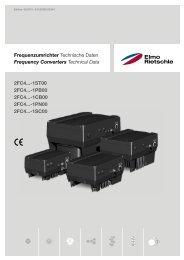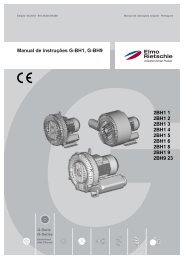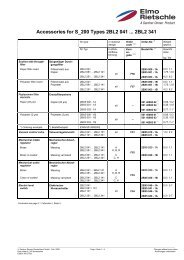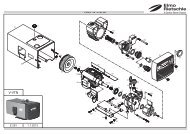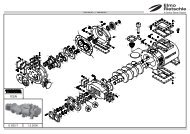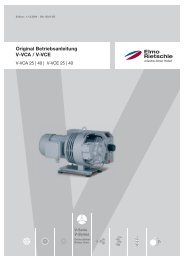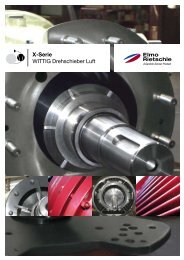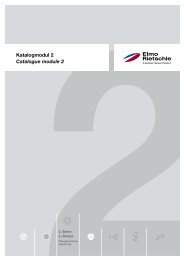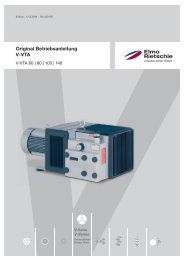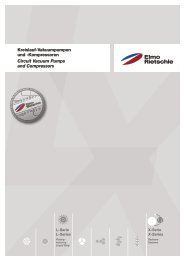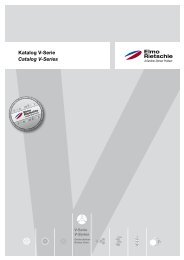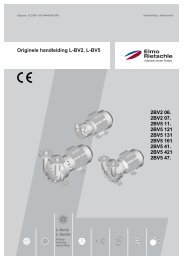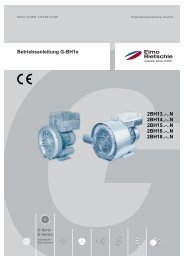SAP Betriebsanleitung - Elmo Rietschle
SAP Betriebsanleitung - Elmo Rietschle
SAP Betriebsanleitung - Elmo Rietschle
Create successful ePaper yourself
Turn your PDF publications into a flip-book with our unique Google optimized e-Paper software.
<strong>SAP</strong> (01) <strong>SAP</strong> (02)<br />
A<br />
�<br />
B<br />
Q Q<br />
Suitability<br />
The units <strong>SAP</strong> are suitable for use in the industrial field i.e. the protection equipments corresponds to EN DIN 294 table 4, for people<br />
aged 14 and above.<br />
<strong>SAP</strong> models can be operated as vacuum pumps or compressors. They are suitable for use with air of a relative humidity up to 90% but not aggressive<br />
gases. Gas tight versions are available. The tightness of each unit depends on the shaft seal. The shaft seal lifetime relates directly to the operating<br />
conditions.<br />
Dangerous mixtures (i.e. inflammable or explosive gases or vapours), water vapour or aggressive gases must not be handled.<br />
Handling of inflammable or aggressive gases and vapours is only possible with special versions, if the safety instructions XE 1 are noted.<br />
Operation in potentially explosive areas is not permissible.<br />
The ambient and suction temperatures must be between 5 and 40°C. For temperatures outside this range please contact your<br />
supplier.<br />
For less aggressive media an internal protection coating can be utilised.<br />
The maximum permissible pressure difference for vacuum or pressure depends upon the motor rating. This is indicated on the data plate (N) and<br />
is shown in the data sheet for standard voltages and frequency:<br />
<strong>SAP</strong> 50, <strong>SAP</strong> 90, <strong>SAP</strong> 110, <strong>SAP</strong> 150, <strong>SAP</strong> 180 see data sheet D 545/1 or D 645/1<br />
<strong>SAP</strong> 220, <strong>SAP</strong> 300, <strong>SAP</strong> 380, <strong>SAP</strong> 450 see data sheet D 545/2 or D 645/2<br />
<strong>SAP</strong> 530, <strong>SAP</strong> 710, <strong>SAP</strong> 1060, <strong>SAP</strong> 1500 see data sheet D 545/3 or D 645/3<br />
Operating above these pressure differences the motor would be overloaded. As well as considering the maximum allowable pressure difference,<br />
the amperage should also be checked against the data plate (N).<br />
The loading of each unit depends on the specific gravity of the gas handled. Therefore when handling gases other than air, there are other pressure<br />
difference limits to be considered. Please contact the supplier for further advice.<br />
If it is possible for the flow to be throttled more than the allowed limits, then the use of vacuum or pressure limitation valves (optional extras) should<br />
be considered.<br />
The maximum permissible internal pressure is 3.5 bar(abs). With this pressure the performance is reduced.<br />
For all applications where an unplanned shut down of the blower could possibly cause harm to persons or installations, the<br />
corresponding safety backup system must be installed.<br />
Handling and Setting up (pictures �, � and �)<br />
Pumps that have reached operating temperature may have a surface temperature at position (Q) of more than 70°C. WARNING! Do<br />
Not Touch.<br />
The blower, especially when the units are built-in, the cooling air entries (E) and the cooling air exits (F) must have a minimum distance of 10 cm<br />
from any obstruction. The discharged cooling air must not be re-circulated.<br />
<strong>SAP</strong> units can be operated in different positions.<br />
<strong>SAP</strong> (01) models can be installed on a solid floor without bolting down. When installing <strong>SAP</strong> (02) models, i.e. motor vertically upwards, you must<br />
secure against torque reaction on start-up. When fitting onto framework we<br />
recommend using anti-vibration mounts.<br />
For installations that are higher than 1000 m above sea level there will<br />
be a loss in capacity. For further advice please contact your supplier.<br />
�<br />
X<br />
B<br />
A



